-
IntroRegardless of the activity, basics and technique are crucial to our success. Technique is literally the “how” of what we do. We want to make sure that the technique we use on the instruments allows us to get as much done with as little effort as possible. Consistency of technique will also help us perform more predictably. This is very important as we learn how to take the ideas we have in our heads and begin to communicate them through our hands.
-
Grip: Step 1Obviously, holding the sticks or mallets is very important. We want to hold the implements in such a way that maximizes the natural strength of our hands, and allows us to maximize the leverage of the stick/malletPoint to the first joint of the index finger. Great! Now, point to the pad of the thumb. These two points are what we will refer to as “The Fulcrum”. The fulcrum is important because 1) it is the main contact point with the stick 2) It allows the stick to move like a seesaw when we need to maximize leverage.
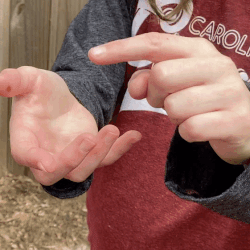
-
Grip: Step 2Place the two points of the fulcrum on opposite sides of the stick/mallet at 1/3 of the length up from the butt of the stick/mallet.
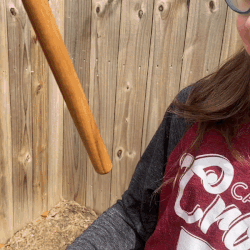
-
Grip: Step 3Now, just wrap the remaining fingers around the stick comfortably. The butt of the stick/mallet should rest comfortably at the base of the pinky.
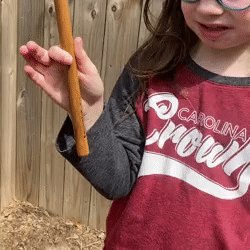
-
Wrist MechanicsFor this next part, put your sticks down. Don't worry, we'll get back to them in a bit. Put your hands out in front of you with your wrists flat (palms facing the floor). Now, bend your hand all the way up, and then all the way down. For most people, there will be a full 180° range of motion with this hand orientation.
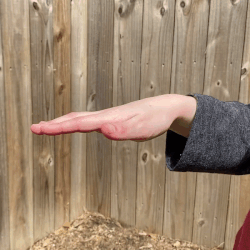 For contrast, put your hand into "handshaking position". Move your hand all the way up, then all the way down. You'll find that you have much less range of motion in this orientation. For this reason, we are going to use the "flat palms" hand position.
For contrast, put your hand into "handshaking position". Move your hand all the way up, then all the way down. You'll find that you have much less range of motion in this orientation. For this reason, we are going to use the "flat palms" hand position.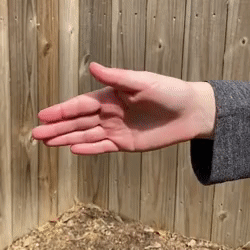 It doesn't mean that the "handshake" orientation is "wrong", we will use that hand position in other applications (namely, timpani, and drum set ride cymbal). However, for the beginning percussionist who is focusing on snare drum and mallets, the "flat palms" orientation works well to help create the rebound. This is helpful, especially when playing on mallet instruments.
It doesn't mean that the "handshake" orientation is "wrong", we will use that hand position in other applications (namely, timpani, and drum set ride cymbal). However, for the beginning percussionist who is focusing on snare drum and mallets, the "flat palms" orientation works well to help create the rebound. This is helpful, especially when playing on mallet instruments. -
Setting the Instrument HeightBefore we start playing, let's get the instrument height set correctly.
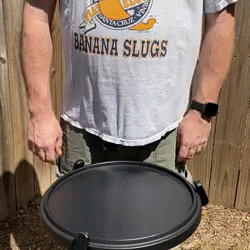
- Extend your pinky finger and thumb
- With your thumb facing up and your pinky facing down, place your thumb at your belly button
- Set the height of the instrument to the tip of your pinky.
Note: This applies to height-adjustable keyboard instruments as well -
The SetupLet's get the sticks back in our hands with the proper grip. Place the two points of the fulcrum on opposite sides of the stick/mallet at 1/3 of the length up from the butt of the stick/mallet. Then, just wrap the remaining fingers around the stick comfortably. The butt of the stick/mallet should rest comfortably at the base of the pinky.Now that we've reestablished our grip, let's get set up to play the instrument.
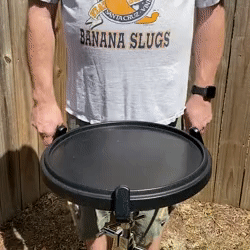
- While standing at your instrument, start with your hands by your side, hanging comfortably down from your relaxed shoulders.
- While keeping your shoulders relaxed, raise your sticks/mallets up to the instrument
- The tips of the sticks/mallets should be together, your palms/wrists should be flat, and there should be a 90° angle between the sticks/mallets. Just imagine two slices of delicious pizza slices.
-
The StrokeWithout adjusting the fingers, the grip, or rotating the arm, use your wrist like a hinge to raise the stick up. Now, using the same motion in reverse, lower the stick back to the instrument.
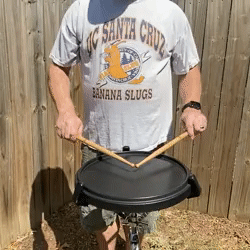
Practice these motions slowly on your own for a little bit. -
Stroke Type #1: Legato StrokeWith your stick in the "up" position (tip of the stick 12 inches above playing surface), quickly drop the stick to the instrument. Once the instrument is struck, allow the stick to quickly rebound back to the starting position.
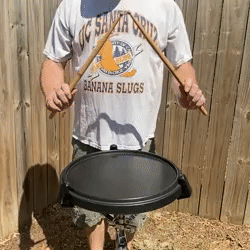
Congratulations! You just played a "Legato" or "Rebound" stroke!
Legato strokes are used when we want to play an accented note which will be followed by another accented note. -
Stroke Type #3: Tap StrokeStart with your stick in the "Down" position so that the tip of the stick is 3 inches above the playing surface. Without prepping, or lifting the stick before you play, quickly drop the stick to the instrument and immediately rebound to the 3 inch starting position.
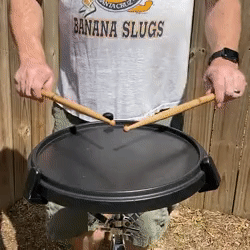
Congratulations! You just played a "Tap"
Tap strokes are used when we want to play an unaccented note which will be followed by another unaccented note. -
Stroke Type #2: Staccato StrokeStart with your stick in the "up" position as if you are going to play a legato stroke. Drop the stick to the instrument, but control the rebound to three inches as if you were playing a tap stroke.
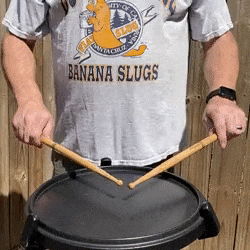
Congratulations! You just played a "Staccato" or "Down" stroke!
Staccato strokes are used when we want to play an accented note which will be followed by an unaccented note. -
Stroke Type #4: Up StrokeStart with your stick in the "down" position with the tip of the stick 3 inches above the playing surface. Without prepping or lifting the stick beforehand, play the instrument then rebound up to a full stroke as if you are finishing with a legato.
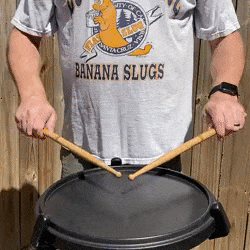
Congratulations! You just played an "Up" stroke!
Legato strokes are used when we want to play an unaccented note which will be followed by an accented note. -
Putting the Strokes TogetherNow we are going to play the four stroke types in sequence.
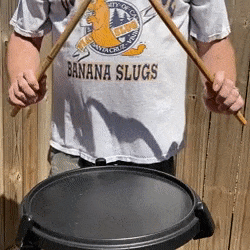
- Legato
- Staccato
- Tap
- Upstroke
Don't worry about speed. focus instead on execution the technique of each stroke correctly. Repeat the sequence with both hands until you are comfortable with where the stick needs to end up with each stroke. -
Controlling the SticksNow that we are comfortable with our four basic stroke types, let's get our hands moving a little bit more. For the time being, we will concentrate on Legatos as our primary stroke type.We will start by playing an old classic exercise called "Eight on a Hand". Simply stated, we will literally be playing eight notes on the right hand, then eight notes on the left hand. Rinse and repeat.
The purpose here is to:- Stretch out the muscles of the wrists and forearms
- Learn to effectively use the rebound as an integral part of the stroke
- Work on playing in time (always use a metronome!)
- Move the sticks with maximum velocity-of-stroke, and maximum velocity-of-rebound
- Work on staying completely relaxed while doing so.
We should not concern ourselves with speed at this point. If we concentrate on control and relaxation, speed and all the other fun stuff will follow!
Lets get started…Set your metronome to 120 beats per minute (BPM). Play one stroke per beat. "R" is for right hand, and "L" is for left. Repeat the line 4 times. Concentrate on remaining relaxed, using the rebound, playing in time with the metronome, and getting a consistent sound from each stroke.
Only after you can perform each line with no mistakes should you continue on to the next line. Only after you can perform all four lines with no mistakes should you increase the tempo (120 -> 140, 140 -> 160, and 160 -> 180)#1: R R R R - R R R R - L L L L - L L L L
#2: R R R R - L L L L - R R R R - L L L L
#3: R R L L - R R L L - R R L L - R R L L
#4: R L R L - R L R L - R L R L - R L R L
#5: R L R R - L R L L - R L R R - L R L L
More Stick Control exercises can be found in the aptly named and classic book Stick Control for the Snare Drummer by George Lawrence Stone. These exercises are invaluable fo the development of hand coordination! -
Beyond Controlling the Sticks: Building EnduranceHere's the part where we work on building speed….but there is a catch. We are not going to work on playing fast by playing fast. Nope. We are going to work on playing fast by improving our endurance and relaxation. I know it sounds counter-intuitive, but this is the way….We are going to start at the same tempo we ended with in the previous section: 180BPM. To make things simpler at this tempo, we are going to play four strokes per beat at 45 BPM. (You can use a metronome that will subdivide the beat into four parts to help you)
The exercise is called "Minute on a Hand". As you might have guessed, we are going to play on one hand for a minute. Then, brace yourself, we are going to play on the other hand for a minute. We will then add a third minute of double strokes.Once you can play the complete three minute sequence correctly, with relaxed muscles, every note played in time, and with consistent sound quality - only then should you increase tempo gradually. At that time, increase tempo 2 BPM. Yup, you read that correctly. Two. This is a marathon, not a sprint.
This exercise should be played daily along with "Eight (& Four & Two & One) on a Hand" as well as "FUNdamental Strokes". -
Final Basics ThoughtsNow that we've gotten to this point in our playing, we are in a good position to move on to some more advanced material. No matter how advanced our playing gets, it is crucial to revisit these basic concepts frequently.
Now, head on over to the Exercises page to continue your journey.
Happy percussing!
Open all Close all
